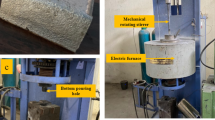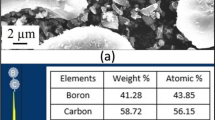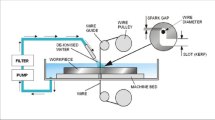Abstract
Reinforcements introduced to metal matrix composites are known for their inherent properties like corrosion resistance, wear resistance and machinability. This study deals with the investigation of the effect of adding tungsten carbide (WC) and graphite (Gr) reinforcements in aluminium alloy (AA 5052) hybrid composite material over the spark erosion machining performance. The composite material was fabricated using stir casting process. The tungsten carbide and graphite particles were introduced in various %-wt combinations to aluminium alloy (AA 5052) as per Taguchi robust experimental design and spark erosion machining was carried out on the composite specimens. Discharge current, voltage and discharge time were chosen as the process parameters and their effect on the output performance was measured using material removal rate (MRR) and average surface roughness (Ra). The optimal set of process parameters and the amount of these particulate reinforcements which either directly or indirectly impact the machining performance were predicted by signal-to-noise ratio analysis and the extent of such impact by each constraint were estimated by employing the analysis of variance (ANOVA). The experimental results showed that the effect of adding WC particles improved the MRR which is proportional to the peak current though surface roughness increases when there is a rise in the peak current at the regions where WC particles are concentrated. Also, compared to tungsten carbide, adding graphite as reinforcement influenced the machining of the composite to a greater extent.
Similar content being viewed by others
References
Jameson EC (2001) Electro Discharge Machining, Society of Manufacturing Engineers (SME)
Reddy PS, Kesavan R, Vijaya Ramnath B (2017) Investigation of mechanical properties of aluminium 6061-silicon carbide, boron carbide metal matrix composite. Silicon https://doi.org/10.1007/s12633-016-9479-8
Pradhan S, Ghosh S, Barman TK et al (2017) Tribological behavior of Al-SiC metal matrix composite under dry, aqueous and alkaline medium. Silicon 9:923–931
Liao YS, Huang JT, Su HC (1997) A study on the machining-parameters optimization of wire electrical discharge machining. J Mater Process Technol 71(3):487–493
Wang CC, Yan BH (2000) Blind hole drilling of Al2O3 p/ 6061 Al composite using electro- discharge machining. J Mater Process Technol 102:90–102
Dhar S, Purohit R et al (2007) Mathematical modeling of electric discharge machining(EDM) of Al- 4Cu- 6Si alloy-10%sic composites. J Mater Process Technol 194:24–29
Mouangue NA, Abdul Rani AM, Ahmad F et al. (2011) Effects of electro-discharge machining on Aluminium metal matrix composite. J App Sci 11:1668–1672
Puertas I, Luis CJ (2003) A study on the machining parameters optimization of electrical discharge machining. J Mater Process Technol 143–144:521–526
UdayaPrakash J, Moorthy TV, Milton Peter J (2014) Experimental investigations on machinabilityof aluminium alloy (A413)/Flyash/B4C hybrid composites using wire EDM. Proc Eng 9(4):502–512
Patel KM, Pulak M et al. (2009) Surface integrity and material removal mechanisms associated with the EDM of Al2O3 ceramic composite. Int J Refr Met Hard Mater 27:892–899
Velmurugan C, Subramanian R, Thirugnanam S, Ananadavel B (2011) Experimental investigations on machining characteristics of Al 6061 hybrid metal matrix composites processed by electrical discharge machining. J EngSci Tech. 3(8):87–101
Daneshmand S, Masoudi B (2017) Investigation of Weight Percentage of Alumina Fiber on EDM of Al/Al2O3 Metal Matrix Composites. Silicon. https://doi.org/10.1007/s12633-017-9562-9
Kumar A, Maheshwari S et al. (2010) Research developments in additives mixed electric discharge machining (AEDM): a state art review. Mater Manuf Proc 25:1166–1180
Karthikeyan R, Lakshmi Narayanan PR, Naagarazan RS (1999) Mathematical modeling for electric discharge machining of Aluminium–silicon carbide particulate composites. J Mater Process Technol 87(1):59–63
Assarzadeh S, Ghoreishi M (2013) Statistical investigation into the effects of electro-discharge machining parameters on WC/6%co composite-part 1: modeling through response surface methodology (RSM). Adv Mater Manuf Charac 3(2):478–486
Yan BH, Tsai HC et al (2005) Examination wire electric discharge machining (EDM) of Al2O3p/6061 Al composites. Int J Mach Tools Manuf 45:251–259
Narender Singh P, Raghukandan K, Rathinasabapathi M (2004) Electric discharge machining of Al-10%SiCpas-cast metal matrix composites. J Mater Process Technol. 156:1653–1657
Iosub A, Axinte E, Negoescu F (2010) A study about micro drilling by electrical discharge method of an Al/ SiC composite. Int J Aca Res 2(3):120–128
George PM, Raghunath BK, Manocha LM (2004) EDM Machining of carbon–carbon composite- a Taguchi approach. J Mater Process Technol 145(1):66–71
Satishkumar D, Kanthababu M et al (2011) Investigation of wire electrical discharge machining characteristics of al 6063/ sic composite. Int J Adv Manuf Technol 56:975–986
Bajaj R, Tiwari AK, Dixit A (2015) Current trends in electric discharge machining using micro and nano powder materials - a review. Materi Today: Proc 2(4):3302–3307
Behera R, Mohanta NR, Sutradhar G (2012) Distribution of sic particulates in stir cast aluminium alloy metal matrix composites and its effect on mechanical properties. Int J Emer Tre Eng Dev 1:194–205
Cichosz P, Karolczak P (2008) Sinker electric discharge machining of aluminium matrix composites. Mater Sci Poland 26(3):2172–2192
Radhika SAR, Kishore Chandran G (2014) Optimization of electrical discharge machining parameters of Aluminium hybrid composites using Taguchi method. J EngSci Technol 9(4):502–512
Vishwakarma M, Parashar V, Khare VK (2012) Advancement in electric discharge machining on metal matrix composite materials in recent: a review. Int J Sci Res Pub 2(3):201–208
Hung NP, Yang LJ, Leong KW (1994) Electric discharge machining (EDM) of cast metal matrix composites. J Mater Process Technol 44:229–236
Lin YC, Wang CA et al. (2009) Machining performance and optimizing machining parameters of Al2O3-TiC ceramics using EDM based on the taguchi method. Mater Manuf Proces 24:152–161
Purohit R, Verma CS, Shekhar P (2012) Electric discharge machining of 7075Al-10 wt.% SiCp composites using rotary tube brass electrodes. Int J Eng Res App 2(2):411–423
Author information
Authors and Affiliations
Corresponding author
Additional information
Research Highlights
• This research work reveals the effect of particulate reinforcements on the spark erosion machining performance of Aluminium hybrid composites.
• The reinforcements chosen in this investigation were tungsten carbide (WC) and graphite particles.
• Spark erosion machining was carried out and the SEM micro-graphs with EDS spectrum reveals the breakdown of WC particles due to the intense heat of the electric discharge.
• Interaction and contour plots reveals the possible interactions between the machining parameters with the level of reinforcements.
Rights and permissions
About this article
Cite this article
Dhas, D.S.E.J., Velmurugan, C. & Wins, K.L.D. Investigations on the Effect of Tungsten Carbide and Graphite Reinforcements during Spark Erosion Machining of Aluminium Alloy (AA 5052) Hybrid Composite. Silicon 10, 2769–2781 (2018). https://doi.org/10.1007/s12633-018-9817-0
Received:
Accepted:
Published:
Issue Date:
DOI: https://doi.org/10.1007/s12633-018-9817-0




